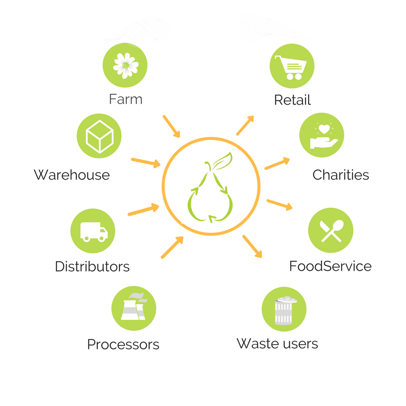Did you know 58% of food produced is never eaten? Food waste is one of the biggest contributors to greenhouse gas emissions in Canada. Studies have shown that avoidable food waste in Canada produces more than 22 million tonnes of climate-changing carbon dioxide emissions. Learn how innovative organizations and companies are tackling this global problem.

Second Harvest, the Toronto-based group working to reduce food waste, commissioned a study that suggested that Canadians waste almost 400 kilograms of food per person, one of the world’s highest totals. This total includes unavoidable waste, such as animal bones, but one-third of the waste could be recovered. Another report by Value Chain says the value of usable groceries that wind up in landfills or other disposal sites is almost $50 billion. That’s more than half the amount Canadians spend on food every year and is enough to feed every Canadian for five months.

A Vancouver based company that is championing food recovery is FoodMesh. By working with municipalities and cities, FoodMesh has created a Canada wide food sharing networking. The have provided over $6 million meals and has helped save over $20 million in food value for organizations using their apps and services. FoodMesh has been growing rapidly and recently announced an expanded program with Metro Vancouver.
The main challenge that both Second Harvest and FoodMesh are tackling is that we don't have a shortage of food but logistical inefficiencies without our food distribution network that create waste.

If food isn't able to be reused or composted locally your next best option is try and reduce the impact that foodwaste has when it is sent to landfill. Tons of rotting food creates methane whic. With the help of Hungry Giant's dehydration machine, we can divert millions of tons of food waste from being tossed in trash dumpsters and hauled to landfills or compost sites. This machine also reduces operating costs for businesses since it reduces the volume of waste that needs to be hauled to landfill. Curious how it works? The Hungry Giant Food Waste Dry Dehydration system (FWDD), turbo-charges the food waste decomposition process through accelerated dehydration and agitation, reducing the original waste volume by between 80 and 93%. Learn more here: https://hungrygiantrecycling.com/
At a personal level, there are now options to reduce your food waste footprint at home even if your local town or city doesn't provide compost/food waste collection services. These are small machines that are designed to reduce your in-home food waste quickly and easily. Both the Lomi by Pela and Tero are Canadian companies that are providing a convenient and easy-to-use option so that no Canadian needs to put food waste in the garbage at their home.
Check out the full list of in-home composting systems from our friends at The Spoon here.


.png?width=371&height=500&name=Untitled%20design%20(12).png)
